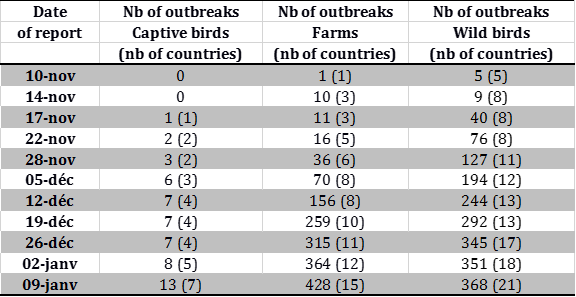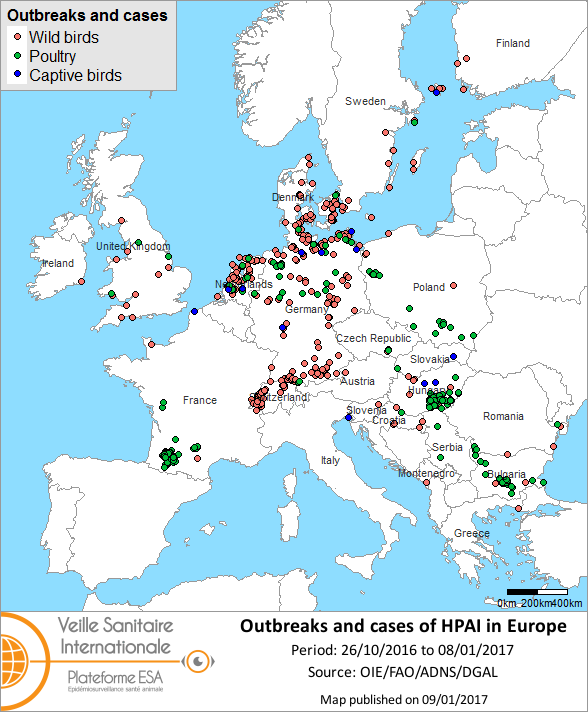Epidemiological situation of HPAI in Europe since October 2016: situation as of 9th January 2017
International Animal Health Epidemic Intelligence (VSI) team – ESA Platform – France
NRL Avian Influenza, Anses laboratory Ploufragan – France
National Office for Hunting and Wildlife – France
Source: Data updated on 08/01/2017 (inclusive) ADNS/FAO/OIE, DGAL (General Directorate of Food – French Ministry of Agriculture)
This is a translation of a published report. The French version of this report is available here.
Two highly pathogenic avian influenza (HPAI) viruses, H5N8 and H5N5, are currently circulating in Europe. Some of these outbreaks are reported to ADNS as “H5” with no further information even though the countries have the subtype information (declarations are as follows: H5 n=226, H5N5 n=3, H5N8 n=603, combined H5N5/H5N8 n=1). The HPAI viruses in general will be analyzed in this report unless mentioned otherwise.
Some countries have detected a HPAI H5N5 virus in wild birds (4 cases of which 3 last week in Montenegro, Italy, the Netherlands and 1 this week in Croatia). The case in the Netherlands is a case of co-infection with H5N8/H5N5.
Since the last situation report on 2nd Jan 2017, 84 new HPAI outbreaks were reported in Europe (European Union and Switzerland), mainly in Bulgaria (25 outbreaks in farms) and in France (20 outbreaks in farms). The virus has been detected for the first time in Slovenia (1 swan in Maribor) and Czech Republic (in Moravia, 3 cases in wild birds and 1 outbreak in a farm). The total number of outbreaks and cases reported in Europe continues to increase and is now 809 (compared to 724 last week), of which 368 were wild birds (58 species affected), 428 in farms, and 13 in captive birds (Table 1 & 2).
The HPAI situation in France is detailed in the website of the ESA Platform in reports from 3 Jan (link), 20 Dec (link), 16 Dec (link), 5 Dec (link), 2 Dec (link), and 30 Nov (link).
An interactive map of outbreaks and cases of HPAI in Europe is also provided (link)
The HP H5N8 virus is also present beyond Europe. After having been detected in Israel (21 outbreaks since November – source: Promed 30/12/2016), Egypt, Tunisia, Iran, Russia and Ukraine (see previous reports), the virus is now present in South Korea (last cases identified in March 2016 – source: Promed 31/03/2016 and 25/12/2016) and Nigeria.
Table 1: Evolution of number of outbreaks and cases of HPAI in the European Union and Switzerland and number of countries affected (in parentheses) reported from 26 Oct 2016 to 8th Jan 2017 (inclusive) (sources: OIE/ADNS/DGAL).
Table 2: Number of outbreaks and cases of HPAI in the European Union and Switzerland reported from 26 Oct 2016 to 8th Jan 2017 (inclusive) (sources: OIE/ADNS/DGAL).
The mortality reported in farms is variable depending on the species, but also for a given species, and is calculated based on a limited number of outbreaks. For mono-species farms, the mortality varied from 0.06 to 33% in Gallus gallus farms, around 20 % in turkey farms (but with a 100% mortality rate reported in an outbreak in France), and from 0 to 70% in palmipeds. Although the data must be carefully interpreted (as time of intervention in relation to infection varied, some farms are epidemiologically linked, the beginning of infection is unknown, etc.), it should be noted that this strain appears to have an unusual virulence in breeding palmipeds.
The 58 different species of birds infected in the avifauna in Europe, with their families, are:
- Accipitridae: Eurasian Buzzard, Rough-legged Buzzard, White-tailed Eagle, Eagle spp, Northern Goshawk, Sparrow Hawk
- Anatidae: Northern Pintail, Common Teal, Common Pochard, Tufted Duck, Common Goldeneye, Mallard, Eurasian Wigeon, Gadwall, Whooper Swan, Mute Swan, Northern pintail, Greylag goose, Bean goose, White-fronted Goose, Pink-footed Goose, Greater Scaup, Dark-bellied Brant, Canada Goose, Barnacle Goose, Res-breasted Goose, Black Swan, Common Shelduck, Common Eider, Red-crested Pochard, Common Scoter, Common Merganser
- Ardeidae: Grey Heron
- Ciconiidae: Stork
- Colombidae: Collared Dove
- Corvidae: Eurasian Magpie, Hooded Crow, Common Raven, Carrion Crow
- Dromaiidae: Emu
- Falconidae: Peregrine Falcon
- Laridae: Black-headed Gull, Herring Gull, Mew Gull, Great Black-backed Gull, Yellow-legged Gull, Lesser black-backed Gull
- Pelecanidae: Great white Pelican
- Phalacrocoracidae: Great Cormorant
- Podicipedidae: Great-crested Grebe, Little Grebe
- Rallidae: Common Moorhen, Eurasian Coot
- Scolopacidae: Curlew spp, Green Sandpiper
- Strigidae: Eagle Owl
Figure 1: Outbreaks and cases of HPAI reported in the European Union and Switzerland from 26 Oct 2016 to 8th Jan 2017 (inclusive) (sources: OIE/FAO/ADNS/DGAL).
The European Commission and the FAO are calling on Member States to reinforce and maintain vigilance for wild birds and poultry.
References:
- The Global Consortium for H5N8 and Related Influenza Viruses 2016. Role for migratory wild birds in the global spread of avian influenza H5N8, Science, 14 Oct 2016:Vol. 354, Issue 6309, pp. 213-217. DOI: 10.1126/science.aaf8852
- H5N8 highly pathogenic avian influenza (HPAI) of clade 2.3.4.4 detected through surveillance of wild migratory birds in the Tyva Republic, the Russian Federation – potential for international spread, Empreswatch septembre 2016
- EFSA, 2014. Highly pathogenic avian influenza A subtype H5N8. EFSA Journal 2014;12(12):3941, 32 pp. doi:10.2903/j.efsa.2014.3941
Previous reports:
- « Situation épidémiologique IAHP H5N8 en Europe depuis octobre 2016 : point de situation au 02/01/2017 » du 02/01/2017 (lien)
- « Situation épidémiologique IAHP H5N8 en Europe depuis octobre 2016 : point de situation au 26/12/2016 » du 27/12/2016 (lien)
- « Situation épidémiologique IAHP H5N8 en Europe depuis octobre 2016 : point de situation au 19/12/2016 » du 19/12/2016 (lien)
- « Situation épidémiologique IAHP H5N8 en Europe depuis octobre 2016 : point de situation au 12/12/2016 » du 12/12/2016 (lien)
- « Situation épidémiologique IAHP H5N8 en Europe depuis octobre 2016 : point de situation au 05/12/2016 » du 05/12/2016 (lien)
- « Recrudescence de foyers d’IAHP H5N8 en Europe en octobre et novembre 2016 : actualisation au 28/11/2016 à 12h00 » du 28/11/2016 (lien)
- « Recrudescence de foyers d’IAHP H5N8 en Europe en octobre et novembre 2016 : actualisation au 22/11/2016 » du 24/11/2016 (lien)
- « Recrudescence de foyers d’IAHP H5N8 en Europe en octobre et novembre 2016 : actualisation au 17/11/2016 » du 17/11/2016 (lien)
- « Recrudescence de foyers d’IAHP H5N8 en Europe en octobre et novembre 2016 » du 10/11/2016 (lien)



